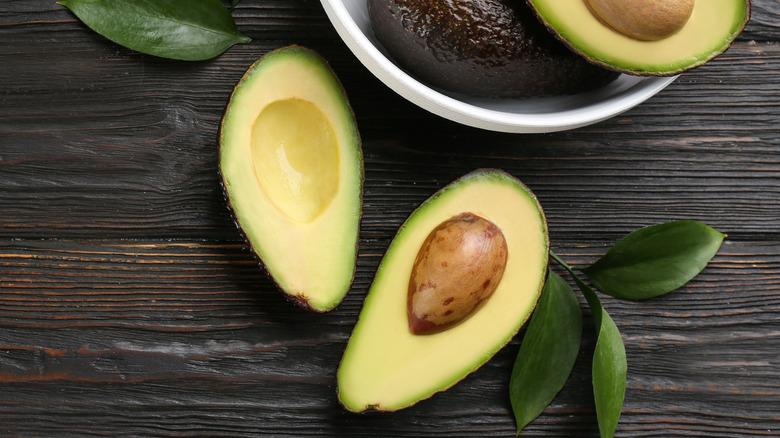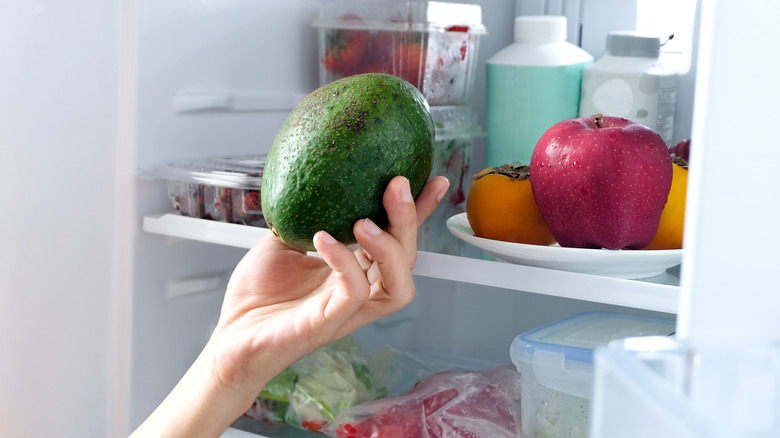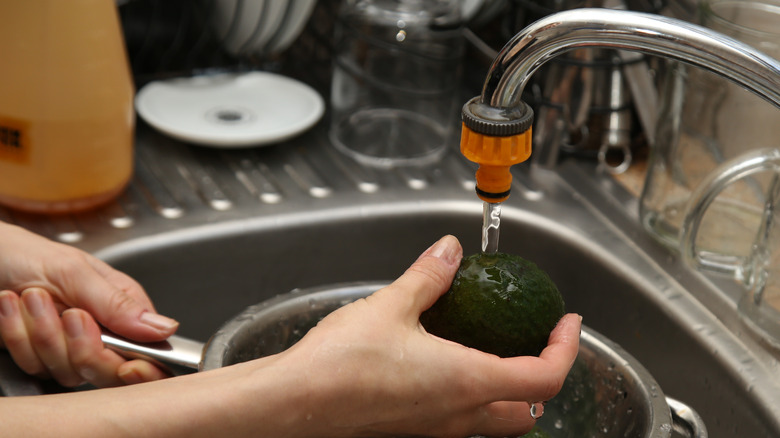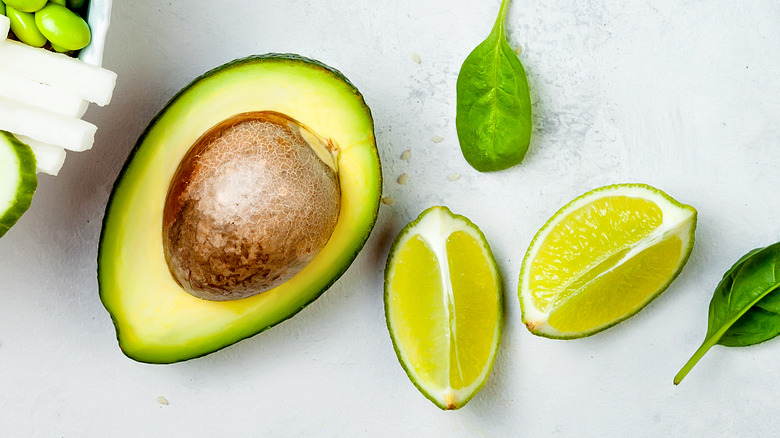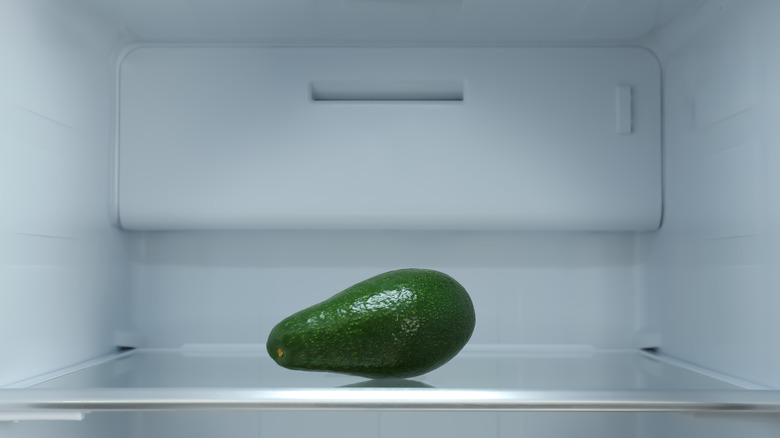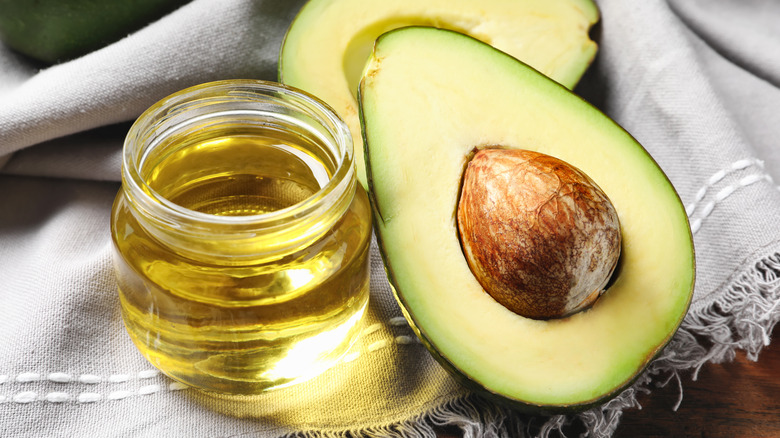The Best Ways To Keep Avocados Fresh
Avocados aren't exactly the most shelf-stable food. You have to buy them at exactly the right stage of ripeness in order for them to be perfectly green and buttery when you're ready to use them. Then after your avocados reach peak ripeness, it's all a matter of keeping them fresh. As soon as you slice into one, the clock starts ticking, because if left uncovered for too long, it'll eventually lose its vibrant green color. While an oxidized avocado may still be edible, there's nothing appetizing about brown guacamole or grey avocado toast.
Considering how naturally temperamental they can be, keeping avocados fresh can be a bit of a challenge. If you store them properly, however, avocados can remain fresh for longer than you'd think. Sick of tossing all the avocados you paid good money for? Just follow these tips for prolonging their freshness and you won't have to worry about it again.
Refrigerator
Sticking your avocados in the fridge right after you buy them may seem like the easiest way to keep them fresh, but according to Allrecipes, this only works under the right circumstances. First, your avocados have to already be ripe. The point of refrigerating avocados is to keep them at a temperature that slows the ripening process, thereby allowing them to stay fresh longer instead of over-ripening then going bad soon after. If you refrigerate under-ripe avocados, all you're doing is delaying yourself from being able to use them. In that case, it's best to keep them on the counter instead.
Since the temperature is the most important factor in this storage method, where you place the avocados in the fridge also makes a big difference. All Recipes therefore recommends the crisper drawer. Being chilled in a low-humidity environment like a vented crisper drawer allows the avocados to remain fresh for an extra two to three days.
Water bath
Apparently the expression "water is the elixir of life" applies to the life of an avocado, too. If you've only used up half of an avocado, don't go reaching for the plastic wrap just yet. According to Well and Good, submerging avocado in water is much more effective. All you need to do is fill a container with water, and make sure you place the avocado with the flesh side down. This method works whether or not the pit is intact, and in both alkaline water and filtered water.
The reason behind this method is that the water creates a natural seal, preventing excess oxygen from coming in contact with the polyphenol oxidase in the avocado. The less contact the flesh makes with oxygen, the longer the avocado stays fresh. It's best to consume the avocado within 24 hours of it being in the water bath, after which you can pat dry the residual water and cut into it like normal.
Lemon or lime juice
If you add lime juice to your guacamole, you've probably noticed that the more of it you add, the longer it'll last before it starts to turn brown. This occurs because lime juice, as well as lemon juice, is a rich source of citric acid and ascorbic acid (via California Avocado). Both these compounds are beneficial to the freshness of an avocado because not only is citric acid a natural preservative, ascorbic acid is reactive to oxygen. That means instead of oxidation affecting the flesh of the avocado, it affects the ascorbic acid, acting as a first line of defense.
The Spruce Eats adds that citric acid is also a strong antioxidant, so it protects the avocado from a molecular level. But while lemon and lime juice may be great at keeping avocados fresh longer, let's not forget about how they taste. If you use lemon or lime juice to maintain the freshness of your avocados, expect them to develop a more sour flavor.
This method will likely keep your avocado from going brown for at least 24 hours.
Freezer
If your avocado is ripe but you don't plan on using it any time soon, TikTok chef My Nguyen says you can buy more time by putting it in the freezer. Just make sure you freeze it whole. As Taste of Home explains, the avocado skin and seed act as a natural barrier against oxygen. When you remove them and cut into an avocado, the browning process speeds up because of an enzyme present in avocados called polyphenol oxidase.
Many food bloggers claim that the best way to freeze an avocado is to cut it up, put it in a Ziploc bag, and squeeze in some lemon juice, but Nguyen's method of keeping the avocado whole works best. In fact, Food52 debunked the Ziploc method through a series of experiments. When you're ready to eat the avocado, simply let the avocado defrost in a bowl of warm water until it reaches room temperature. As Nguyen explains, the cell walls in the avocado will have broken down a bit, but you'll still be left with a ripe avocado.
Olive oil
If you don't mind your avocados being on the oily side, try olive oil to keep your avocados fresh and green. Today explains that similar to lemon juice, oil functions as a preservative by forming a protective barrier against oxidation. Olive oil in particular does so through the acids it contains, specifically linoleic, palmitic, and oleic acid. For best results with this method, Insider suggests brushing the avocado flesh with a thin coat of olive oil, then sealing it in a covered container. This will allow the avocado to remain fresh for up to four days in the refrigerator before any major browning occurs.
Unfortunately, olive oil is slippery and doesn't adhere particularly well to the actual avocado, so the olive oil ends up pooling in the pit instead, leaving the other parts of the flesh dryer than others. Within the four day timeframe however, you can still enjoy fresh avocados.
